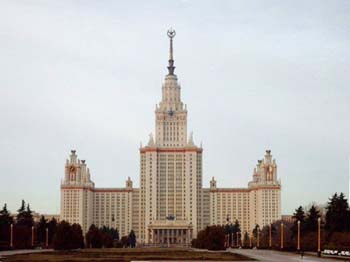The Seven Sisters are the architectural legacy of one of the most ambitious building programmes ever conceived. Built on the orders of Jozef Stalin, the towers were constructed for the glorification of the Soviet State after WWII, and were intended to rival the USA 's skyscrapers that had gone up in the 30s. Each Sister was designed according to Stalin's specifications, in a so-called ‘wedding-cake' style, that concentrated the eye towards a central tower. Stalin also insisted that all of the Seven Sisters be given a spire, in order to distinguish them from their American counterparts.

Ironically the structure that served as the blueprint for the Seven Sisters - The Palace of Soviets - was never built. Conceived before the 2nd World War, The Palace was to be the ultimate symbol of Soviet power and crowning glory of Moscow . A vast structure of 415 metres (the last 100m of which was to be a giant statue of Lenin) The Palace of Soviets would have been the tallest building in the world, should it have been completed. Although a site was prepared for the Palace - the sacred Cathedral of Christ the Saviour was destroyed especially - the chosen ground proved to be too soft for the foundations of such a momentous edifice. With the advent of World War II the project was suspended and never resurfaced. Eventually a public swimming pool was built on the site instead, which functioned until 1994, when Mayor Yuri Luzhkov had the Cathedral of Christ the Saviour rebuilt.
If Stalin lost interest in the Palace of Soviets, then he wasted no amount of energy or money on the construction of the Seven Sisters, or ‘Vysotniye Zdaniye' as they were more officially known (literally meaning ‘The High Buildings'). Situated in key areas around Moscow , these towering skyscrapers are still the dominant feature of the city skyline. The jury is still out as to whether they are beauties or beasts, but what can't be denied is their impressiveness. When you are standing underneath one such tower, engulfed in her gigantic shadow, it is very easy to see how these vast buildings were effective as powerful tools for state propaganda, and for fostering a belief of national superiority.
The Seven Sisters are as follows:
1) Moscow State University
2) Ministry of Foreign Affairs
3) Ministry of Transport
4) Hotel Ukraina
5) Hotel Leningradskaya
6) Kudrinskaya Square (apartment block)
7) Kotelnicheskaya Embankment (apartment block)
The Eighth Sister?
There are two other buildings that are sometimes considered the ‘Eighth Sister', due to their similarity in scale and design to the other seven. The first is the Palace of Culture and Science in Warsaw , part of Stalin's attempt to ‘Communise' Poland and the second is the recently-completed Triumph Palace in Moscow. At 264 metres , it is tallest building in Europe (59th in the world), and contains a thousand luxury residential apartments.